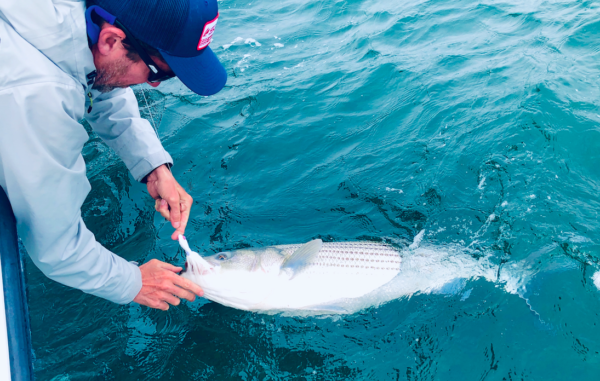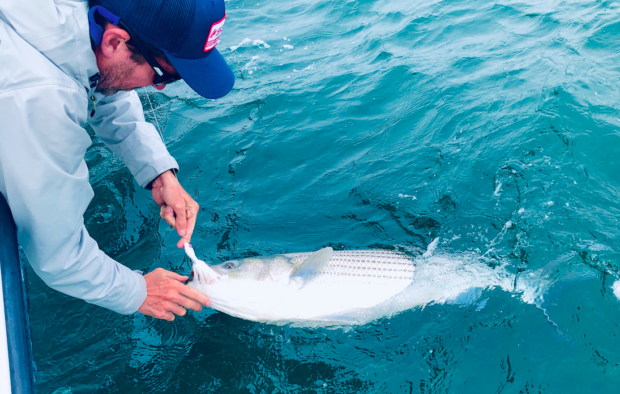ASMFC vs Council (Magnuson-Stevens) Framework
By American Saltwater Guides Association
The Atlantic States Marine Fisheries Commission is the biggest hurdle to striped bass management
Thanks for being patient! The Atlantic States Marine Fisheries Commission meeting that will decide the future of striped bass is only a month away. The entire community has to mobilize if we are to have any hope of recovering the most iconic fish on the East Coast.

Way too many breeders killed to sustain a healthy striped bass fishery. Photo: Derr
Have you ever wondered why our so many species managed by ASMFC are in trouble? How can any commission tasked with managing fish stocks have such an abysmal track record and still exist?
ASMFC was created in 1942 to address food supply concerns during WWII. It was not initially intended to have any authority to manage fisheries. Such authority was only granted, with respect to striped bass, after the Atlantic Striped Bass Conservation Act was made law in 1984; ASMFC had no authority to manage other coastal species until Congress passed further legislation in 1993.
A quarter-century later, ASMFC’s only claim to fame has been the recovery of striped bass in 1995. Today, even that accomplishment has been superseded by too many years of inaction in the face of a declining striped bass stock, which has culminated in the recent stock assessment’s finding that striped bass are overfished and overfishing is occurring.
One can only wonder why fish stocks managed by other federal fishery management councils are recovering while critical species like weakfish, striped bass, river herring/shad, lobster, and American eel are all doing so poorly. We’ve done some research on the issue and our conclusion is that the management system needs to change. We have to stop treating the symptoms and go directly after the disease. The real issue is the framework under which ASMFC operates.
At the federal level, eight regional fishery management councils were set up under The Magnuson Stevens Fishery Conservation and Management Act. Such councils are required, by law, to manage fisheries in a very different way than striped bass are currently managed. If striped bass were managed under a similar framework, it is very unlikely that we would be in the mess that we are in now.
We are about to get technical. There’s no other way to explain the issue in a fair manner. We are going to ride the fine line between delivering the facts and making the article readable for fishermen. We will compare and contrast the management framework between the councils and the commission, and you will see for yourself how ASMFC loopholes are exploited and why our fisheries suffer.
Council Structure/Magnuson Stevens: Striped Bass are not managed this way
Magnuson-Stevens is a comprehensive federal fishery management statute, which governs all fishing in federal waters. However, with very limited exceptions that do not apply to the striped bass fishery, Magnuson-Stevens does not give federal fishery managers the authority to manage fish in state waters, [1] even if the same stock of fish is federally managed when present in the United States Exclusive Economic Zone.[2] Thus, as the law is currently written, federal fishery managers, acting pursuant to Magnuson-Stevens, can’t manage striped bass. But we can seriously consider legislating a new framework for ASMFC that would mirror the structure of a federal fishery management council.
Let’s assume that striped bass could be and could have been managed pursuant to Magnuson-Stevens. In that case, the following provisions of the statute would be relevant.
- National Standard 1, which requires that “Conservation and management measures shall prevent overfishing while achieving, on a continuing basis, the optimum yield from such fishery for the United States fishing industry. [3]
- The definition of “optimum” yield, which states that
“The term ‘optimum’ with respect to the yield from a fishery, means the amount of fish which—
- Will provide the greatest overall benefit to the Nation, particularly with respect to food production and recreational opportunities, and considering the protection of marine ecosystems;
- Is prescribed as such on the basis of the maximum sustainable yield from the fishery, as reduced by any relevant economic, social, or ecological factor; and
- In the case of an overfished fishery, provides for rebuilding to a level consistent with producing the maximum sustainable yield in any such fishery.[4]
- National Standard 2, which requires that “Conservation and management measures shall be based upon the best scientific information available.”[5]
- A requirement that regional fishery management councils “develop annual catch limits for each of its managed fisheries that may not exceed the fishing level recommendations of its scientific and statistical committee or the peer review process established [elsewhere in Magnuson-Stevens].”[6]
- A requirement that every fishery management plan “specify objective and measurable criteria for identifying when the fishery to which the plan applies is overfished (with an analysis of how the criteria were determined and the relationship of the criteria to the reproductive potential of stocks of fish in that fishery) and, in the case of a fishery in which a Council or the Secretary has determined is approaching an overfished condition or is overfished, contain conservation and management measures to prevent overfishing or end overfishing and rebuild the fishery.”[7]
- A requirement that every fishery management plan “assess the type and amount of fish caught and released alive during catch and release fishery management programs and the mortality of such fish, and include conservation and management measures that, to the extent practicable, minimize mortality and ensure the extended survival of such fish.”[8]
- A requirement that every fishery management plan “establish a mechanism for specifying annual catch limits in the plan (including a multiyear plans), implementing regulations, or annual specifications, at a level such that overfishing does not occur in the fishery, including measures to assure accountability.[9]
- A requirement that “For a fishery that is overfished, any fishery management plan, amendment, or proposed regulations…for such fishery shall—
- specify a time period for rebuilding such fishery that shall—







